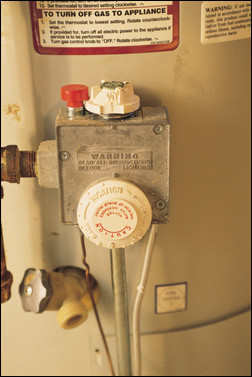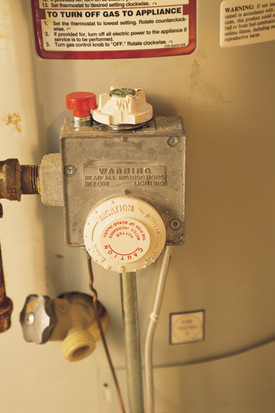Call the Pros
Whether a homeowner is on town water, uses natural gas, or heats with fuel oil or propane, the best source of information for shutting off any of these services in the event of an emergency is the utility company itself. “Every house is different,” says Becky Marquis, deputy director of the Ready Campaign
 Knowing how to shut off gas in your home is critical during emergencies. |
initiated by the Department of Homeland Security. The main water valve for one house may not be located in the same place as a house down the street. Regional construction differences make it difficult to generalize the location and procedure for every utility shutoff. If in doubt about a shutoff detail, a homeowner should always call the experts. For those using propane or fuel oil for heating needs, a call to the company who supplies your fuel should get you the answer.
Water
Burst pipes, leaks, preparation for natural disasters and other situations can require the water to be shut off. For houses serviced with municipal water, the shutoff may be located on the outside or inside of the home. On the home’s exterior, homeowners should look for the main inlet pipe, which may have a faucet handle or a blade handle. Sometimes this pipe also has an outdoor spout attached for lawn watering purposes. Faucet handles close by turning clockwise, and blade handles most commonly close by turning the handle until it is perpendicular to the pipe. Some main water valves require a wrench to shut off, and this valve might be located away from the home. Locating the shutoff valve and making sure it is not covered or concealed by shrubs or other vegetation is important.
If the home does not have an exterior shutoff handle, homeowners should look in the basement or crawlspace near the place where the inlet pipe enters the home. Often, the main shutoff handle can be located there. Garages are common locations as well.
Homes that are supplied water by a private well will have a pressure tank with a pump that draws water in from the well. This system is powered, so cutting power to the pump at the main circuit panel will stop the draw of water into the home. Some tanks may have a separate disconnect unit near the tank itself. Power can be turned off here, too.
However, there should also be a main shutoff valve located between the tank and the pipe that feeds the rest of the house. (If there is not, one should be installed.) This valve (commonly with a blade handle) can, and should, be turned to the off position to prevent the contents of the tank from leaking into the home if there is a leak present. If a leak occurs between the tank and the rest of the home, the contents of the tank will empty through the leak if the shutoff valve is not turned.
If shutting off the home’s water is necessary for the preparation of a natural disaster like a hurricane, it is a good idea to drain the water in the pipes as well by opening a valve somewhere in the home until there is no pressure in the lines. “That way, if there is damage, there won’t be pressure to cause flooding in the home,” says Bill York, an engineering consultant in Florida who has done work for the Federal Alliance for Safe Homes (FLASH). York, who works in a hurricane-prone area of the country, also advises homeowners preparing for a storm to plug any floor drains with an inflatable rubber bladder to prevent sewage from backing up into the home. “The bladders can be purchased at a plumbing supply store or in the plumbing section of a hardware store,” says York.
Individual plumbing fixtures like toilets and sinks will also have their own shutoff valves. The toilet shutoff valve is usually located just behind the toilet, and sink shutoff valves are found under the counter on both the hot and cold feed pipes.
Electrical
“If you see sparking wires or if a circuit blows, it may be indication of compromised wiring,” says Rocky Lopes, manager of Homeland Security and Emergency Management for the National Association of Counties. Earthquakes can undermine a home’s electrical system integrity, and flooding or water in the electrical wiring can also pose a hazard to a home’s occupants.
 Burst pipes, leaks, preparation for natural disasters and other situations can require the water to be shut off. |
Shutting off the home’s electrical system is fairly straightforward. At the main circuit panel (for modern homes) or fuse box (for older homes), a main shutoff switch can cut power to the whole home. This switch should be clearly marked—in fact, all individual circuits should be clearly marked, as well. If a home’s circuits are not marked, the homeowner should take the time to do so.
In the event of an emergency that requires power to be shut off, homeowners should shut off all the individual circuits before shutting off the main switch. Even if power to the home is knocked out, homeowners should turn off the main switch, according to Lopes. “That way you can control when power to the home is restored, and you won’t create a surge when everything turns on.”
Gas and Fuel Oil
The ability to turn off the home’s gas supply is one of the most important to a homeowner as gas hazards pose one of the biggest dangers to the home. Home’s fed by natural gas should have an aboveground meter located outside the home. The shutoff valve will be located on the pipes that connect to the meter. Shutting off this valve requires a wrench. Special gas valve shutoff wrenches available for purchase have openings on either end that fit the standard gas valve. Turning the valve 90 degrees will shut off gas service to the home.
In earthquake-prone states like California, seismically triggered automatic shutoff valves can be purchased by the homeowner and installed by a professional. These devices will automatically disconnect the gas supply to the home in the event of seismic activity. “Installation can be done by a plumber or a specialty contractor,” says Martin Simenc, president of Home Safety Services, a professional home safety consulting service specializing in making homes safer. For homeowners who do not have an automatic shutoff valve, Simenc recommends storing the shutoff wrench adjacent to the meter. Attaching the wrench to the meter by a rope is an easy way to ensure that the tool will always be on-hand in the event of an emergency.
Under no circumstance should a homeowner attempt to restore gas service to the home. A professional must perform this service.
Homeowners who heat with fuel oil or propane should become familiar with the shutoff process for these services. Most systems will have a shutoff switch of some sort, but systems will vary. “For LP or oil, the shutoff is usually at the bottom of the tank or somewhere between the tank and the water heater,” says York. A call to the supplier is the best way to clear up any confusion.
The Family Plan
Once a homeowner determines the shutoff procedures for each utility, it is a good idea to put these procedures down on paper and to familiarize each family member (provided they are old enough) with the procedures. A map or layout of the home indicating the location of each shutoff valve or handle is another smart step to take. “Everyone should be involved in the family plan,” says Lopes. “If parents are away, you want other family members to know what to do.” Lopes recommends gathering the family and playing a “what if” game, as in ‘what if an earthquake happened? What would you do?’ “It’s not meant to be a scary process,” says Lopes. “It’s better to talk about it ahead of time.”
 |
||||
|
||||
With a layout and shutoff instructions in hand, the homeowner should make copies and keep them in relevant and easy-to-find locations. Simenc keeps one copy inside a kitchen cabinet door where a babysitter or relative can easily find it and follow the instructions in the case of an emergency. Posting shutoff instructions near the shutoff location (the valve for the water system or circuit panel for electricity) is smart.
Stay Informed
In the event of an emergency or disaster, homeowners should stay informed by listening to the radio or watching the TV. Officials will usually notify homeowners as to whether or not certain utilities should be shut off and whether or not they need to evacuate. A National Oceanic and Atmospheric Administration (NOAA) radio is a useful device for any home. This radio turns on automatically when national or local emergency warnings need to be broadcast. They can usually be purchased for $30 to $50.
Credit: Renovate Your World




























